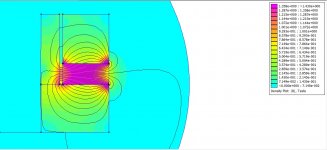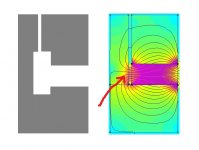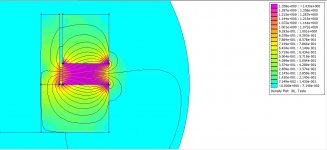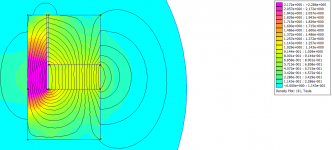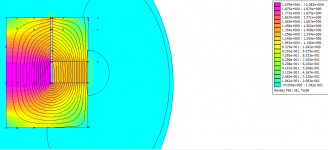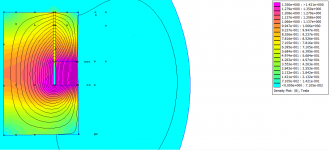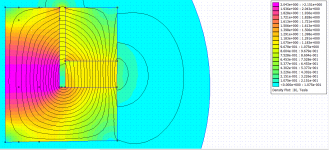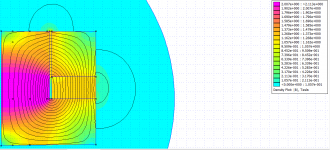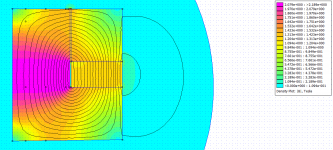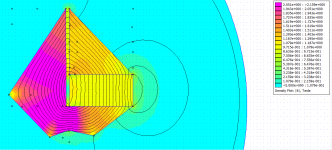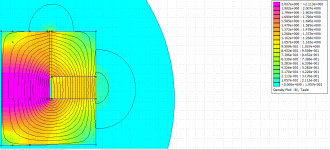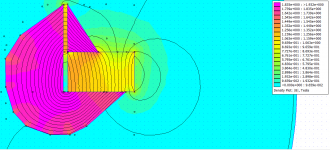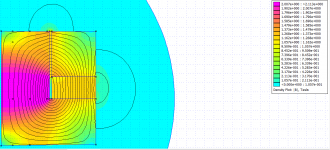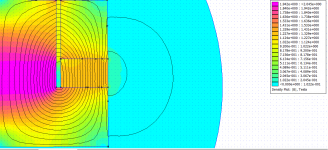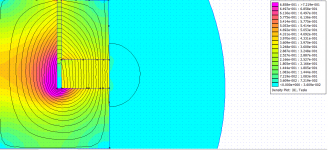Thanks Flow. I managed to use FEMM to simulate the flux density. Will post the simulations once I get the exact dimensions.
Ordered some parts :
- Nomex(220 Deg C) and Kapton sheets (0.15mm thick) for coil former.
- 31, 33 and 35 AWG enamelled copper wires (200 Deg C enamel rating).
- Tinsel lead out wires
- Spider and foam surrounds for a 4'' and 7'' cone from AurisAudio
Ordered some parts :
- Nomex(220 Deg C) and Kapton sheets (0.15mm thick) for coil former.
- 31, 33 and 35 AWG enamelled copper wires (200 Deg C enamel rating).
- Tinsel lead out wires
- Spider and foam surrounds for a 4'' and 7'' cone from AurisAudio
FEMM results using 20mm thick top and bottom pole pieces with 1.3mm air gap.
An N52 92mm OD, 72.5mm ID, 9.05mm thick ring neo magnet was used for simulations to replace the 8X smaller neos.
Absolutely terrible flux through the gap!! Vikash you were right!
Lot of improvements to be done....
An N52 92mm OD, 72.5mm ID, 9.05mm thick ring neo magnet was used for simulations to replace the 8X smaller neos.
Absolutely terrible flux through the gap!! Vikash you were right!
Lot of improvements to be done....
Attachments
Can't believe I got the magnetization direction wrong.
what happens if you do this ?
oh, btw
remember, this is only one side of the curcuit
but may not change that much
Attachments
You can use this for ref:
An externally hosted image should be here but it was not working when we last tested it.
Tinitus, there is so much flux that there is no way I can do that without making the voice coil bigger. 2'' coil at the moment. It is saturated even with a 10mm vent hole!
Flow, I have resized the magnet. Result seems to be incredible.
About 1T through 1mm gap, 20mm height !
If I have 10m of coil length, does the BL become 10Tm?
Flow, I have resized the magnet. Result seems to be incredible.
About 1T through 1mm gap, 20mm height !
If I have 10m of coil length, does the BL become 10Tm?
Attachments
Yeah, the pole-piece is still saturated. This is one of the reasons why VC diameter is increased in general.. First, could you please set the grid in femm to 1.0?
femm->view->show grid
femm->view->set grid
So we could see the distances more easily.
"If I have 10m of coil length, does the BL become 10Tm? "
Not directly.. Bl depends on the flux (or flux curve) throu the gap. Just place two points above and below the gap and draw a line ('red line') (contours) between the two points.
plotxy-> B.n
BL is the product of the length of the wire and this curve (an integral). You can calculate this in femm just read thru the femm woofer tutorial.
edit: if you have an underhung design, then yes, it will become 10Tm
rgds,
Akos
femm->view->show grid
femm->view->set grid
So we could see the distances more easily.
"If I have 10m of coil length, does the BL become 10Tm? "
Not directly.. Bl depends on the flux (or flux curve) throu the gap. Just place two points above and below the gap and draw a line ('red line') (contours) between the two points.
plotxy-> B.n
BL is the product of the length of the wire and this curve (an integral). You can calculate this in femm just read thru the femm woofer tutorial.
edit: if you have an underhung design, then yes, it will become 10Tm
rgds,
Akos
Last edited:
Grid attached.
Results for 20mm top and bottom pole pieces for gap of 0.5mm, 1mm and 2mm.
Flux density of 1.3T, 1.1T, 0.9T respectively.
Result looks good quite promising for such a thick top pole piece.
Will attach few more graphs tomorrow for 10mm top pole piece instead. (Xmax reduced to (10-5)/2 = 2.5mm.
Results for 20mm top and bottom pole pieces for gap of 0.5mm, 1mm and 2mm.
Flux density of 1.3T, 1.1T, 0.9T respectively.
Result looks good quite promising for such a thick top pole piece.
Will attach few more graphs tomorrow for 10mm top pole piece instead. (Xmax reduced to (10-5)/2 = 2.5mm.
Attachments
1010 steel or better. Going for a gap of 1 or 1.5mm.
Sailboat weight-saver Neo vs standard (both 1mm gap, 20mm tall pole piece).
1.1 T vs 0.85 T
Considerable weight saving but at the cost of flux and machining.
I prefer a heavy chunk of steel any day!
Sailboat weight-saver Neo vs standard (both 1mm gap, 20mm tall pole piece).
1.1 T vs 0.85 T
Considerable weight saving but at the cost of flux and machining.
I prefer a heavy chunk of steel any day!
Attachments
- Status
- This old topic is closed. If you want to reopen this topic, contact a moderator using the "Report Post" button.
- Home
- Design & Build
- Parts
- Axial or Diametrical neo magnets for homemade speaker?
